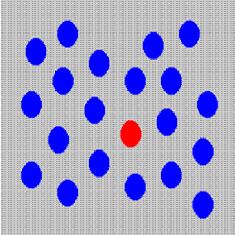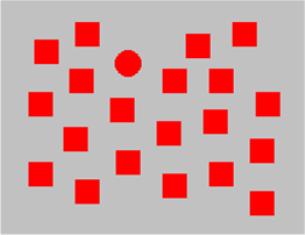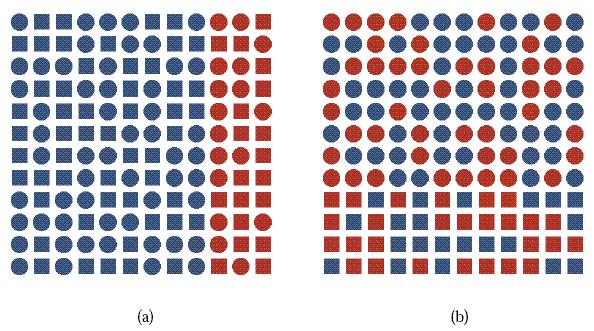Preattentive processing: Difference between revisions
Incorporated work of Horst Kargl and Ali Akcaglayan |
Removed SPAM |
||
| (13 intermediate revisions by 2 users not shown) | |||
| Line 1: | Line 1: | ||
{{ | {{Quotation|'''Preattentive processing''' of visual information is performed automatically on the entire visual field detecting basic features of objects in the display. Such basic features include colors, closure, line ends, contrast, tilt, curvature and size. These simple features are extracted from the visual display in the preattentive system and later joined in the focused attention system into coherent objects. Preattentive processing is done quickly, effortlessly and in parallel without any attention being focused on the display.|[Treisman, 1985, Treisman, 1986]}} | ||
{{Quotation|Typically, tasks that can be performed on large multi-element displays in less than 200 to 250 milliseconds (msec) are considered preattentive.|[Healey, 2005]}} | {{Quotation|Typically, tasks that can be performed on large multi-element displays in less than 200 to 250 milliseconds (msec) are considered preattentive.|[Healey, 2005]}} | ||
Latest revision as of 08:58, 27 August 2007
Taking advantage of preattentive processing in information visualization can greatly improve intuitiveness of representations yielding in a faster and more natural way of acquiring information.
Preattentive Features
A partial list of preattentive visual features, together with references to research that showed they were preattentive.[Chipman, 1996],
Detecting the Red Object preattentively.[Healey et al., 1996] One visual variable and very easy to find it.
Detecting the Circle preattentively.[Chipman, 1996] It is more difficult but still preantentiv.
Examples of two target detection tasks: (a) target can be detected preattentively because it possess the feature “filled”; (b) target cannot be detected preattentively because it has no visual feature that is unique from its distractors.[Healey et al., 1996]
Region segregation by form and hue: (a) hue boundary is identified preattentively, even though form varies randomly in the two regions; (b) random hue variations interfere with the identification of a region boundary based on form.[Healey et al., 1996]
Conclusion
Any visual processing of that item prior to the act of selection can be called “preattentive”.[Wolfe, Treisma, 2003]
Preattentive processing can help to rapidly draw the focus of attention to a target with a unique visual feature (i.e., little or no searching is required in the preattentive case). [Healey, 2005]
External Links
- Perception in Visualization by Christopher Healey (includes many examples and applets on preattentive processing)
References
- [Chipman, 1996], Gene Chipman, Rewiev of High Speed Visual Estimation Using Preattantive Processing (Healy, Booth and Enns), Created at: 1996, Access Date: 24.October.2005. http://www.cs.umd.edu/class/spring2002/cmsc838f/preattentive.ppt#267
- [Healey, 2005]: Christopher G. Healey, Perception in Visualization, Retrieved at: 2005. http://www.csc.ncsu.edu/faculty/healey/PP/index.html
- [Healey et al., 1996], Healey, C. G., Booth, K. S., and Enns, J. T. High-Speed Visual Estimation Using Preattentive Processing. ACM Transactions on Human Computer Interaction 3(2), pages 107-135, 1996. http://www.csc.ncsu.edu/faculty/healey/download/tochi.96.pdf
- [Kosara et al., 2002],Robert Kosara, Silvia Miksch, Helwig Hauser. Focus+Context Taken Literally IEEE Computer Graphics & Applications (CG&A), Special Issue on Information Visualization, 22(1), pages 22-29, January/February 2002. http://www.kosara.net/papers/Kosara_CGA_2002.pdf
- [Treisman, 1985] A. Treisman, Preattentive Processing in Vision, Computer Vision, Graphics, and Image Processing, 31(2):156-177, August 1985.
- [Treisman, 1986] A. Treisman, Features and Objects in Visual Processing, Scientific American, 255(5):114-125, 1986.
- [Wolfe, Treisma, 2003], Jeremy M Wolfe, Anne Treisma, What shall we do with the preattentive processing stage: Use it or lose it?, Todd S Horowitz poster presented at the Third Annual Meeting of the Vision Sciences Society, Sarasota, May 2003 http://search.bwh.harvard.edu/links/talks/VSS03-JMW.pdf




